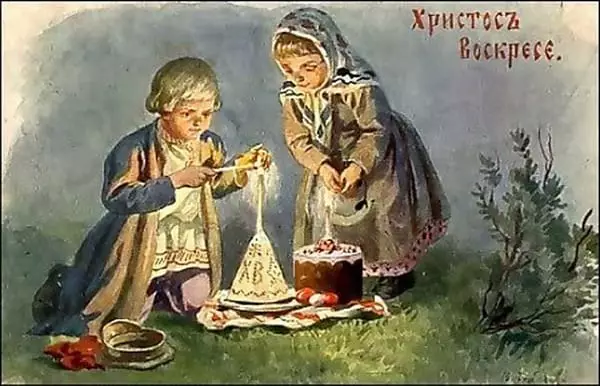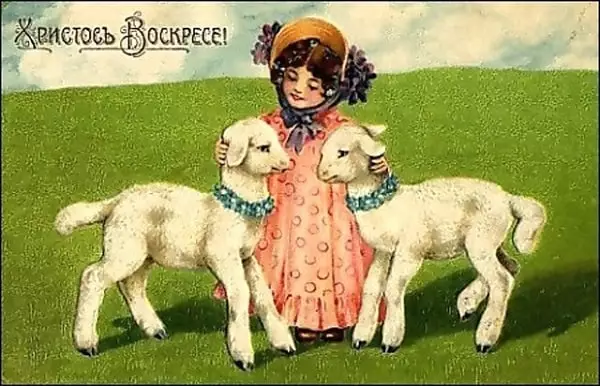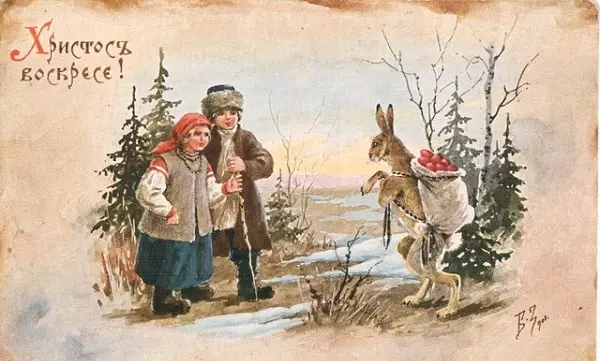Almost every Christian has this holiday associated with the words "Christ Risen!" However, from the Bible it is known that this holiday was for the ancient Jews something else. When did people be celebrated to celebrate Easter, what did this holiday mean for them? What roots have modern Easter symbols?

Easter before the birth of Christ
For the ancient Jews of Easter (or rather, Pesach, which is translated as "pass by") was a holiday related to the outcome of their people from Egyptian slavery. In ancient times on this day, each family had to be slaughtered an annual lamb (which is why this animal was the main and oldest symbol of the holiday). Later, the customs changed, and the ritual food was exclusively matza (desalination).Find out what awaits you today - a horoscope for today for all zodiac signs
By numerous subscribers requests, we have prepared an accurate horoscope application for a mobile phone. Forecasts will come for your zodiac sign every morning - it is impossible to miss!
Download free: Horoscope for every day 2020 (Available on Android)
According to the ancient legend, the Messiah (Jewish king) had to appear in Jerusalem for Easter. Therefore, people so happily met Christ, who entered the city on the Oslice a few days before the celebration. And for the same reason, the deception is so alarmed. Fearing the popular uprising and the fact that Jesus who had a big impact on people would want to encroach on power, they grabbed him and executed.
Light resurrection

The calendar of Orthodox (and not only) holidays dedicated to Easter is not limited to the resurrection of the Lord.
- The great Thursday, during which the secret evening occurred (according to the one, the apostles described this day, it becomes clear that it was the celebration of the Jewish Easter). At night of this day, due to the betrayal of Judah, Iskariot, the Son of God was captured.
- Good Friday. The day of the execution of the Lamb of God (again referring to Pesachu: this holiday was made to lay the lambs as a sign of the ritual victim to God).
- Great Saturday. At the time when the whole city celebrates Easter, the high priests are ordered to guard the body of Christ, afraid that the disciples will decorate him and declare that he was risen as promised.
- Resurrection of Christ. Myrova's wife comes to the tomb in which Jesus buried to ask the guards to wash the body, but the tomb is closed with a large stone. The Lord sends an angel from the sky, who falls off the stone and shows an empty tomb, told women that there is no one they are looking for, "he is resurrected.
We remind: in those days, weekends ending the week was Saturday. Today's Sunday is a tribute to the very holiday.
- After 8 days, the Son of God came to the disciples. The Apostle Thomas said before that he would not believe in the resurrection of his teacher, until he saw him with his own eyes (therefore, in our people, the surveillance story appeared). Jesus asks him to touch his wounds in his palms.
- Ascension of the Lord. 40 days Jesus preaches students and other faithful people. On the 40th day he is ascended into the sky.
- Pentecost. On the 50th day, the disciples receive the gifts of the Holy Spirit. Orthodox on this day celebrate the trinity.
Ancient Christians celebrated the sufferings of Christ each Friday (this day was a day of grief and fasting), and Sunday is his joyful return to life. Later, this holiday began to celebrate only on the anniversary of the death of Christ. In the 2nd century, all the Christian churches have already been honored: during the Jewish Pescha, they celebrated "Easter Lounge", and on Sunday - "Easter joy."
Over time, in different churches there was an "Easter dispute", since in different countries this holiday began to celebrate at different times. Emperor Konstantin Great in 325 in the city of Naquea convened the cathedral (the congress of representatives of all churches), which was subsequently called the first universal. They decided to count the celebration First Sunday after the first spring full moon . The main point of this reform was: to establish a celebration not one day with the Jewish Pesach.
True, at that time people continued to celebrate two Easter: sad and joyful. And only in the 5th century, this title began to designate only a joyful Sunday holiday.
Why are the dates of the celebration of Orthodox and Catholics agree?
- 1582 year. Pope Grigory The Thirteenth (Roman Catholic Church) introduced his own Easter, because of which the entire festive calendar has changed, afterwarding the name in honor of his "author" - Gregorian. In this calendar, Easter can be celebrated not only later than Jewish, but also before her, and even coincided with her. In one year, she can coincide with the Orthodox, to the other - differ for a week, and in the third - a month.
- 1923. The fourth, Constantinople Patriarch, the Christian Congress created another calendar called Novyuliansky. Orthodox Romania, Serbia, Greece passed on him.
- As for the old style (Julian calendar), the temples of Georgia, Russia, Belarus, Ukraine (not all), as well as Athos still use them.
10 interesting facts about this holiday

- The holiday has many characters that fall on the tables of celebrating people. For example, this is the Lamb, about whom we have already written above (in our country, the cake is often baked in the form of a lamb, and in the southern countries there is still a young lamb for Easter). In addition, in our days, Easter symbolize chicken and chickens (here comments are superfluous, because we paint or paint eggs). And from the West, fashion came to us on Easter rabbits, a symbol of spring fertility (modern kids love chocolate bunnies very much, they even began to sanctify in the church on a par with herbs).
- Modern paint and pussy are decorated with different colors and patterns. But the most traditional is considered red. Legend is connected with this color. Maria Magdalene went to the Emperor Tiberius, bringing him a chicken egg (as it was not accepted on the audience to come with empty hands) and proclaiming that Jesus Christ was resurrected. To which the emperor skeptically noticed: "Can't stand dead, just like this white egg cannot suddenly become red." At this moment, the egg in the eyes of all those present blushed. The affected emperor exclaimed: "Truly risen"!
- Easter eggs - traditional children's fun. In Slavic countries, children are competing, whose egg will ride longer, or (as in Ukraine) knock on the egg about his friend, checking who it is stronger. As for Europe and America, here adults are hiding colored eggs in the house or in the yard. Children are looking for them, considering that they found the "Easter Rabbit nest". And, of course, if the baby was naughty, in his courtyard a festive rabbit with a call will not look at the neck!
- And in Bulgaria its entertainment. In this country, clay pots are discarded on Easter from the roofs of houses.
- The Greeks, as well as the inhabitants of many Latin America launch near the church of the big bonfire, where Judah Icyariot is thrown, wanting to punish it in such a way. Often, this ritual burner is accompanied by fireworks.
- Little girls in Sweden on this day are drawn by witches and, armed with a copper cauldron, walk along the neighbors, demanding candy.
- As for the American kids, they are most competed in the riding eggs along the path. This fun is so popular that the president is organized annually in front of the White House. Hundreds of kids go to ride their crawls on the presidential lawn.
- Now many buy chocolate, bead or wooden eggs. But this Easter symbol can be from another material. For example, the most expensive eggs are recognized by the jewelry of Peter Charles Faberge, the German by nationality living in pre-revolutionary Russia. In 1883, Tsar Alexander ordered the master the whole Easter set, wanting to make a gift to his venance spouse.
- Kulich - holiday symbol. Meanwhile, in the ancient books there is no mention of such a festive baking. The fact is that special spring bread is a pagan tradition, which in our country swallowed in church rules. But modern hostesses adorn cakes with crosses, making this baking like a small temple.
- On this day, it was necessary to finish with all the relatives. It is convenient to do if you live in one city or village, because at Easter everything traditionally go to visit. But what if your relatives are far? In this case, hundreds of festive cards were published in pre-revolutionary times (and not only in Russia), which people sent relatives and friends. We decided to decorate our article!
Orthodox traditions
- Returning from the church with consecrated crumbs in the early morning, Orthodox Christ (not only exchange ritual greetings "Christ is risks" - "truly resurrected"), but also three times, which was repeatedly shown on holiday postcards. In the vintage days, this custom lasted not one, and 40 days.
- Fellow fire. It is lit in the church of the Mernel. The priests deliver it from Jerusalem in their cities, spreading in different churches. Believers can buy a lamp and a candle and after the service to bring this fire to their home. It is believed to be supported during the year.
- On the occurrence of Easter loudly notice the bells. On this day, all believers can climb the bell tower and try themselves as a role. Of course, the children run there first. That's sound and joyfully in the church yard! Especially if you consider that before that, all the bells were long silent in the sign of sadness in the passions of Christ.
- Traditionally, most of the festive works (baking cakes, the manufacture of Pasok from cottage cheese, staining eggs) is made in the great Thursday. Also this holiday is called clean, so the hostess these days wash the windows and are cleaned in the house. Well, of course, what a clean day without swimming the entire family!
And there is also an opinion that Easter's Slavic countries are closely related to many old magical beliefs. Is it really? The answer is in this short documentary:
